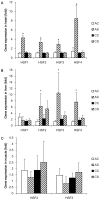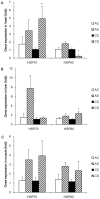Differential expression of heat shock transcription factors and heat shock proteins after acute and chronic heat stress in laying chickens (Gallus gallus)
- PMID: 25072282
- PMCID: PMC4114549
- DOI: 10.1371/journal.pone.0102204
Differential expression of heat shock transcription factors and heat shock proteins after acute and chronic heat stress in laying chickens (Gallus gallus)
Abstract
Heat stress due to high environmental temperature negatively influences animal performances. To better understand the biological impact of heat stress, laying broiler breeder chickens were subjected either to acute (step-wisely increasing temperature from 21 to 35°C within 24 hours) or chronic (32°C for 8 weeks) high temperature exposure. High temperature challenges significantly elevated body temperature of experimental birds (P<0.05). However, oxidation status of lipid and protein and expression of heat shock transcription factors (HSFs) and heat shock proteins (HSPs) 70 and 90 were differently affected by acute and chronic treatment. Tissue-specific responses to thermal challenge were also found among heart, liver and muscle. In the heart, acute heat challenge affected lipid oxidation (P = 0.05) and gene expression of all 4 HSF gene expression was upregulated (P<0.05). During chronic heat treatment, the HSP 70 mRNA level was increased (P<0.05) and HSP 90 mRNA (P<0.05) was decreased. In the liver, oxidation of protein was alleviated during acute heat challenge (P<0.05), however, gene expression HSF2, 3 and 4 and HSP 70 were highly induced (P<0.05). HSP90 expression was increased by chronic thermal treatment (P<0.05). In the muscle, both types of heat stress increased protein oxidation, but HSFs and HSPs gene expression remained unaltered. Only tendencies to increase were observed in HSP 70 (P = 0.052) and 90 (P = 0.054) gene expression after acute heat stress. The differential expressions of HSF and HSP genes in different tissues of laying broiler breeder chickens suggested that anti-heat stress mechanisms might be provoked more profoundly in the heart, by which the muscle was least protected during heat stress. In addition to HSP, HSFs gene expression could be used as a marker during acute heat stress.
Conflict of interest statement
Figures





Similar articles
-
Effect of dietary manganese on antioxidant status and expressions of heat shock proteins and factors in tissues of laying broiler breeders under normal and high environmental temperatures.Br J Nutr. 2016 Dec;116(11):1851-1860. doi: 10.1017/S0007114516003822. Epub 2016 Nov 28. Br J Nutr. 2016. PMID: 27890044
-
Basal and dynamics mRNA expression of muscular HSP108, HSP90, HSF-1 and HSF-2 in thermally manipulated broilers during embryogenesis.BMC Vet Res. 2019 Mar 8;15(1):83. doi: 10.1186/s12917-019-1827-7. BMC Vet Res. 2019. PMID: 30849975 Free PMC article.
-
The effect of dietary phosphorus on heat shock protein mRNAs during acute heat stress in male broiler chickens (Gallus gallus).Comp Biochem Physiol C Toxicol Pharmacol. 2004 Jan;137(1):11-8. doi: 10.1016/j.cca.2003.10.013. Comp Biochem Physiol C Toxicol Pharmacol. 2004. PMID: 14984699
-
[Regulation of heat shock gene expression in response to stress].Mol Biol (Mosk). 2017 May-Jun;51(3):400-417. doi: 10.7868/S0026898417020100. Mol Biol (Mosk). 2017. PMID: 28707656 Review. Russian.
-
Prospects of engineering thermotolerance in crops through modulation of heat stress transcription factor and heat shock protein networks.Plant Cell Environ. 2015 Sep;38(9):1881-95. doi: 10.1111/pce.12396. Epub 2014 Aug 6. Plant Cell Environ. 2015. PMID: 24995670 Review.
Cited by
-
Differential expression of heat shock protein 90, 70, 60 in chicken muscles postmortem and its relationship with meat quality.Asian-Australas J Anim Sci. 2017 Jan;30(1):94-99. doi: 10.5713/ajas.16.0132. Epub 2016 May 12. Asian-Australas J Anim Sci. 2017. PMID: 27189635 Free PMC article.
-
Gill Oxidative Stress Protection through the Use of Phytogenics and Galactomannan Oligosaccharides as Functional Additives in Practical Diets for European Sea Bass (Dicentrarchus labrax) Juveniles.Animals (Basel). 2022 Nov 28;12(23):3332. doi: 10.3390/ani12233332. Animals (Basel). 2022. PMID: 36496852 Free PMC article.
-
Effects of heat stress and a low energy diet on blood parameters and liver hsp70 and iNOS gene expressions in local chickens.Vet Anim Sci. 2021 Nov 20;14:100221. doi: 10.1016/j.vas.2021.100221. eCollection 2021 Dec. Vet Anim Sci. 2021. PMID: 34877436 Free PMC article.
-
Effect of dietary betaine supplementation on the liver transcriptome profile in broiler chickens under heat stress conditions.Anim Biosci. 2023 Nov;36(11):1632-1646. doi: 10.5713/ab.23.0228. Epub 2023 Aug 30. Anim Biosci. 2023. PMID: 37654169 Free PMC article.
-
Zinc alleviates the heat stress of primary cultured hepatocytes of broiler embryos via enhancing the antioxidant ability and attenuating the heat shock responses.Anim Nutr. 2021 Sep;7(3):621-630. doi: 10.1016/j.aninu.2021.01.003. Epub 2021 Apr 24. Anim Nutr. 2021. PMID: 34401540 Free PMC article.
References
-
- Feder ME, Hofmann GE (1999) Heat-shock proteins, molecular chaperones, and the stress response: evolutionary and ecological physiology. Annu Rev Physiol 61: 243–282. - PubMed
-
- Horowitz M (2002) From molecular and cellular to integrative heat defense during exposure to chronic heat. Comp Biochem Physiol A Mol Integr Physiol 131: 475–483. - PubMed
-
- Pardue ML, Ballinger DG, Hogan NC (1992) The heat shock response. Cells coping with transient stress. Ann N Y Acad Sci 663: 125–138. - PubMed
-
- Morimoto RI (1993) Cells in stress: transcriptional activation of heat shock genes. SCIENCE-NEW YORK THEN WASHINGTON- 259: 1409–1409. - PubMed
-
- Morimoto RI, Kline MP, Bimston DN, Cotto JJ (1997) The heat-shock response: regulation and function of heat-shock proteins and molecular chaperones. Essays Biochem 32: 17–29. - PubMed
Publication types
MeSH terms
Substances
Grants and funding
LinkOut - more resources
Full Text Sources
Other Literature Sources

